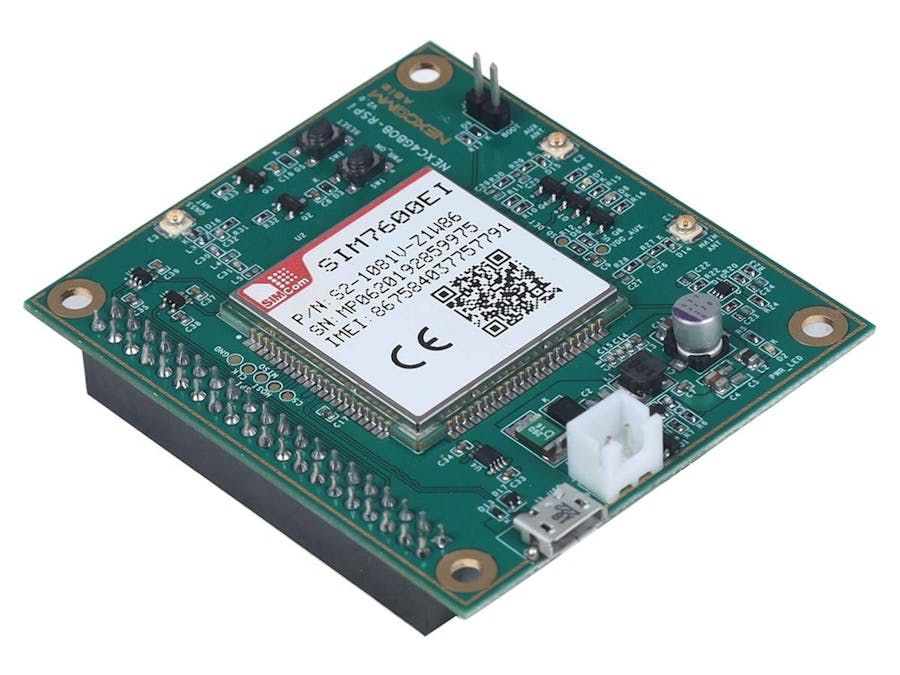Parry Technology's “SIM7600 series, 4G LTE Raspberry Pi HAT” is a Multi-Band 4G/3G/2G communication and GNSS positioning module, which supports LTE-CAT1 or LTE-CAT4 speeds. This product is designed to be compatible with Raspberry Pi(RPi) board for 4G LTE data connectivity applications such as IoT, supporting UART and USB interfaces. USB interface enables the module to be also connected to Windows/Linux/Android PCs or Industrial PCs. UART interface enables easy interface with Microcontrollers.
Features• 4G LTE HAT board with Raspberry Pi compatible 40pin GPIO header.
• Worldwide 4G/3G/2G communication coverage. Supports VoLTE.
• GNSS supporting GPS, BeiDou, GLONASS, LBS positioning.
• USB data interface to connect with Raspberry Pi /Windows /Linux /Android PCs or embedded host. UART interface with Raspberry Pi is also provided.
• Can be powered through Raspberry Pi USB or external +5V ± 5%
• Supports mail, TCP/ IP/ IPV4/ V6 Multi-PDP, MT PDP, and FTP/ FTPS/ HTTP /HTTPS /MQTT/ DNS.
• LTE module’s Power supply on/off by Raspberry Pi I/O.
• Proper RF layout design on a four-layer PCB for optimal RF performance and low current consumption.
• Provision for antenna matching circuit components.
• Firmware update of LTE module via USB/FOTA.
Raspberry Pi Connector detailsPrerequisites:
- Raspberry Pi board,
- 5V, 3A power adapter for Raspberry Pi,
- External monitor with HDMI interface,
- USB cable to connect Raspberry Pi to HAT
- 4G LTE HAT board,
- USB mouse and USB Keyboard,
- SD Card for Raspberry Pi,
- 4G SIM card,
- LTE Antennas for Main and Auxiliary ports, GNSS active antenna and necessary antenna cables to connect the antennas.
· Connect all the peripheral as shown in the figure above. Connect the LTE main antenna, diversity antenna and GNSS antenna to the 4G HAT board’s Main Port Aux port and GNSS Port, respectively. For the RF connector locations, refer the following figure:
· Insert the SIM card into the SIM card holder provided in the bottom side of 4G LTE HAT board. Insert 4G LTE HAT board on top of the Raspberry pi and connect USB cable with 4G LTE HAT board to one of the USB port of Raspberry pi. This provides both power to the HAT board and serial communication channel between Raspberry Pi and HAT boards.
· When Raspberry Pi power adapter is connected and powered ON, the PWR indicator LED (Vcc Status LED) on the 4G LTE HAT board will be glowing continuously, indicating that the 4G LTE HAT board is powered ON.
· Press the PWRKEY button on the HAT board, hold it for 1s and then release. Wait for 10-12 seconds, for the NET indicator (Network status LED) to start blinking. Generally, the NET indicator will fast flash initially (1 time per second), which means that the SIM7600 4G module has not logged in the Network. After logging in, the indicator become to flash slowly (1 time every three seconds). This process of SIM card registration and logging in to the local cellular network will last several seconds to dozens of seconds.
Raspberry Pi setupInstall Raspbian OS on SD CardFormat SD card:
- Download and install SD Card formatter from below URL: https://www.sdcard.org/downloads/formatter/eula_windows/index.html
- Insert SD card in card reader and connect to PC/Desktop.
- Open SD card formatter application, Select the SD card, type of format and then click on format.
- After successful format, proceed to flash the image into SD card.
Flash Raspbian Image to SD card:
- Download raspberry pi imager application from the below URL to flash Raspbian image into SD card.
https://www.raspberrypi.org/downloads/
- Click on Download For WINDOWS. After successful download, extract zip file -> click on.exe file and install.
- Download Raspbian image from below URL.
https://www.raspberrypi.org/downloads/raspberry-pi-os/
NOTE: Here, Raspbian OS with Kernel version 5.4 is used to interface and test SIM7600 4G BOB functionalities.
- Select “Raspbian OS with desktop and recommended software (32 bit)” and then click on Download.
- After successful Download, Follow below steps:
open Raspberry Pi imager application
↓
click on CHOOSE OS
↓
Select Use custom
↓
select downloaded image
↓
click on choose SD card
↓
select SD card
↓
click on WRITE.
- Wait for the Raspberry Pi Imager to finish writing
- After successful flashing of Raspbian OS into SD card, a popup message will be appear as shown below then SD card can be ejected.
- Insert the SD card that was flashed with Raspbian image into the SD card holder in Raspberry Pi.
- Connect keyboard, mouse, and Monitor with Raspberry Pi as shown in the "SIM7600 Raspberry Pi 4G Hat Setup" section.
- Insert SIM card into the SIM card holder. Connect the LTE and GNSS antennas to the 4G HAT board.
- Connect 4G HAT board’s Micro USB port to one of the Raspberry Pi USB Port and mount the 4G HAT board on Raspberry Pi using the 40-pin connector as shown in the figure below.
- Power on Raspberry Pi board with 5V, 3A Adaptor.
- After powering ON the Raspberry Pi board, red LED will glow on 4G LTE HAT board, which indicates 4G LTE HAT board is powered ON successfully. (Note: In case if the 4G HAT board is not powered, use python script developed by us to power ON SIM7600 4G LTE HAT board).
- Loaded Raspbian image can be seen on monitor which shows that the Raspberry Pi board is successfully powered with the Operating system.
- Press the Power key switch button on 4G LTE HAT board for 1 second to power ON the SIM7600 4G module used in the 4G HAT board. (Note: SIM7600 module can also be powered ON using Raspberry Pi I/O using python script developed by us).
- Upon successful power ON of SIM7600 LTE module, blue LED will glow on 4G LTE HAT board as indicated in the above Figure.
- After successful power up, SIM card needs to be registered to the network for which, flight mode ON/OFF sequence needs to be done. This can be done through Raspberry Pi I/O or through AT commands. The procedure for these are explained in the user guide.








Comments
Please log in or sign up to comment.